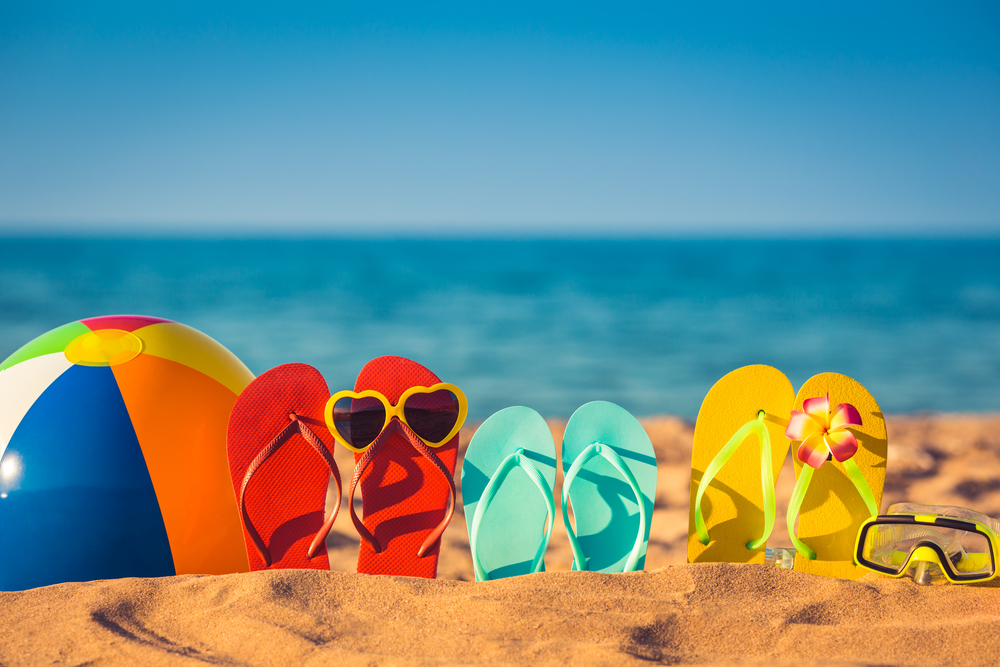Many newly arriving refugees and humanitarian parolees are about to experience their first summer in the United States. Depending on where they have settled, they may find themselves in an unfamiliar weather environment with new summer activities available to them. These new environments may include exposure to extreme and prolonged heat, different UV indexes, and having the opportunity to play in or near water.
The Best Summer is a Safe Summer
Being outdoors with friends and family is enjoyable and healthy, and it decreases the risk of catching contagious illnesses like COVID-19. Service providers play an important role in making sure clients have the information they need to make informed choices for themselves and their family so they can safely enjoy the summer in their new community.
The information below about extreme heat and water safety will help service providers become more knowledgeable so they can educate clients about these topics. In addition, the client-facing NRC-RIM Multilingual Heat and Water Safety flyers can be given to clients to introduce or reinforce the safety guidance. These flyers are available in 10 languages: Arabic, Dari, English, French, Kinyarwanda, Pashto, Russian, Spanish, Swahili, and Ukrainian.
Heat Safety
Extreme heat can be deadly. 2022 was the third hottest year on record in the U.S., and summer temperatures are expected to continue to rise. Some groups of people—such as infants, children, the elderly, or those who do strenuous activities outdoors—are at higher risk of heat-related illnesses such as heat stroke, heat exhaustion, heat cramps, and heat rash.
Here are tips service providers can give to clients to help them stay safe in the summer heat:
Recommend lightweight, loose-fitting clothing. Certain fabrics, such as linen and cotton, are more comfortable than others when the weather is hot.
Encourage clients to stay in an air-conditioned place as much as possible. If the client’s home does not have air conditioning, even a few hours in a public space such as a shopping mall, school, or public library can help them stay cool before they go back into the heat. You may suggest local heat-relief shelters or cooling centers that might be able to provide relief for people who are experiencing a heat wave and do not have sufficient cooling. See the National Center for Healthy Housing’s Cooling Centers by State, or call 2-1-1 for resources and more information on local cooling centers. If possible, have this list translated into clients’ languages so they can locate the shelter nearest to them.
For clients who may be concerned about budgeting, the Low-Income Home Energy Assistance Program (LIHEAP) Clearinghouse has state cooling programs available as a resource to support vulnerable households in paying for utility bills or obtaining cooling equipment.
Note: Clients may have electric fans at their disposal, but these provide limited relief when temperatures rise above 90 degrees Fahrenheit (32 Celsius). Emphasize to clients that using only electric fans will not prevent the onset of heat-related illnesses. Taking cool showers or moving to an air-conditioned place are more effective ways to cool off.
Encourage limiting outdoor activity to the coolest times of day, like morning and evening hours.* Clients should take breaks and rest often in shady areas to recover. Those playing sports or exercising outdoors should drink water often. Remind clients that if they feel unwell at any time, they should immediately stop all activity, move to a cooler place, rest to get their heart rate down, and hydrate slowly. Counsel them to seek medical attention if symptoms get worse or don’t improve.
Emphasize consumption of extra fluids through drinks and food, even when not doing strenuous activities. Advise clients to drink water throughout the day. Clients should also be advised that tap water is safe to drink in the U.S. and that they do not need to purchase bottled water, as it is cost prohibitive. Reusable aluminum or plastic water bottles may be secured via local food banks, procured as donations, or purchased at second-hand stores, and they should be washed thoroughly with hot water and soap prior to use. New arrivals coming from warm countries will likely be familiar with hydrating foods; consider discussing the different cultural foods and drinks that incorporate hydrating ingredients. For those unfamiliar with the best hydrating foods, fruits higher in water are an excellent recommendation. Oranges, watermelons, cucumbers, pineapples, and apples are easy to find at supermarkets and food banks. Keep printed lists of local food banks that clients can take home.
Emphasize the use of sunscreen and heat protection accessories. Many people are unaware that all skin tones are susceptible to sun damage or sunburn, while others may not be familiar with sunscreen. Guide newcomers through the benefits of sunscreen with an SPF of 30 or higher, and draw attention to how every skin tone benefits from sunscreen use. Though sunscreen may be out of budget for some, encourage clients to check whether their local food bank distributes sunscreen, or consider doing a sunscreen drive at your agency. Depending on where you live, it’s possible that parks and beaches may also offer free sunscreen kiosks. If people cannot access sunscreen, suggest using sunglasses, wide hats, umbrellas, and light-weight long-sleeved clothing.
Advise against staying in parked cars even for short periods of time. While newly arrived clients may not have their own car, they may be accepting rides from a friend or neighbor. Remind clients that staying in a parked car for as little as 10 minutes can prove dangerous. Even with the windows open, cars heat up very quickly, and on an 80-degree Fahrenheit (26 Celsius) day, a parked vehicle can reach internal temperatures of 90 degrees Fahrenheit (34 Celsius) in 10 minutes. Passengers inside, especially children or older adults, are at increased risk of heat stroke or death. When cars are parked, passengers should leave the car and move to shade or an indoor, air-conditioned area while they wait. Children and pets should never be left alone in a parked car, even with the windows open. Remind clients to bring bottled water for car trips or easily transportable hydrating snacks such as oranges and apples.
Provide language-specific Extreme Heat Flyers to clients in their preferred language: Arabic, Dari, English, French, Kinyarwanda, Pashto, Russian, Spanish, Swahili, or Ukrainian.
Water Safety
For many people, summer means time in pools or lakes or at the beach swimming or playing in water. It is important for service providers to remember that many clients have never had the opportunity to learn to swim or to be around pools or open bodies of water. For some clients, water may even be associated with traumatic experiences that occurred during their migration, such as dangerous boat crossings. Sadly, drowning is a leading cause of accidental death in children in the U.S., so it is crucial for newcomers to learn the basics of water safety.
Protection in and around water: It is important to swim only in areas authorized or marked safe for swimming. Service providers can educate clients about common flags, signs, or banners that warn against unsafe swimming conditions. Advise clients to never swim alone, even with lifeguards and other swimmers around. Children should always be supervised by an adult. Very young children can drown in as little as 1 to 2 inches of water, and a person who is drowning** may not be able to call or signal for help, so it’s even more important to stay alert. Clients also may not be familiar with the proper attire to wear for the water. Wearing regular or street-clothing can pose a hazard, as it may become weighty and cumbersome when wet. Clients should be encouraged to wear appropriate swimwear and reminded that there are often affordable options at chain stores or thrift stores, including swimwear for those wanting more modest options.
Having basic water skills and water equipment: Clients planning to be in or around water should have basic water safety skills, like knowing how to float and tread water. Service providers can find free or reduced-cost swim classes in their community and disseminate this information to clients. It is important for beginning swimmers or anyone in an open body of water, regardless of age, to wear a life jacket. Advise clients to check the label inside a life jacket and look for the words “US COAST GUARD APPROVAL” followed by a number starting with 160.064. This number indicates the Federal regulation under which the jacket was approved for use. These life jackets can be found for as little as $15 at department stores. Clients should be made aware of what counts as a properly fitted life jacket. A well-fitting life jacket will fit comfortably over the body—not so loose that it lifts over the head in the water, and not so tight that breathing is uncomfortable.
Teach children to ask permission for water-based activities. Some children may be experienced swimmers. Even so, advise clients that they should teach their children to ask permission to play in the water. Children engaging in water-based activities should always be supervised by an adult.
Know the risks before taking a dip. Even experienced swimmers should be advised to remain aware of the type of body of water they are swimming in. Swimming in pools is very different from swimming in rivers and the ocean. Each environment comes with its own risk factors. No swimmers, even experienced swimmers, should use alcohol or drugs (including certain prescription medications) prior to participating in water activities.
*Outdoor activities that allow adequate space and air flow between individuals can lower the risk of spread of COVID-19 compared to indoor activities. COVID vaccines are the best way to protect from severe COVID infections.
**Dry drowning is when airways constrict due to water inhalation. Even small amounts of water can cause vocal cords to close up, resulting in dry drowning.
Provide language-specific Water Safety Flyers to clients in their preferred language: Arabic, Dari, English, French, Kinyarwanda, Pashto, Russian, Spanish, Swahili, or Ukrainian.
Helpful Resources
Providers are encouraged to use the below English-language resources from the Centers for Disease Control and Prevention (CDC) and American Red Cross to build their own knowledge regarding hot weather and water-related safety in order to best inform newcomer clients.
Signs of Heat-related Illness
This resource helps you identify the different types of heat illnesses and provides tips on what to do if you or a loved one experiences a heat-related illness.
AVOID – STOP – TREAT
This resource provides picture-based information about avoiding heat exposure, identifying signs and symptoms of heat stroke and heat exhaustion, and treating heat-related illnesses.
Helping with Drowning
This list from the Red Cross provides advice on how to identify a water emergency and how to best assist in that situation.
Water Safety Tips
This easy-to-understand page illustrates the most fundamental water safety tips. Print it out and display it in high-traffic areas of provider offices. This resource can also be distributed to clients to keep on their refrigerators for their family’s reference.
Swimming Safety Video
This video, created by Settle In, is offered in Dari, Pashto, Russian, and Ukrainian and provides tips about how to stay safe when swimming.
Find a Learning Provider
The first step in water safety is knowing how to swim. This interactive tool helps you find a Red Cross swim lesson provider near you.
Hot Weather Safety
This all-in-one tool from the National Weather Service covers tips for all hot weather safety, including heat-related illnesses, heat forecasts, and what to do during a heat wave.










